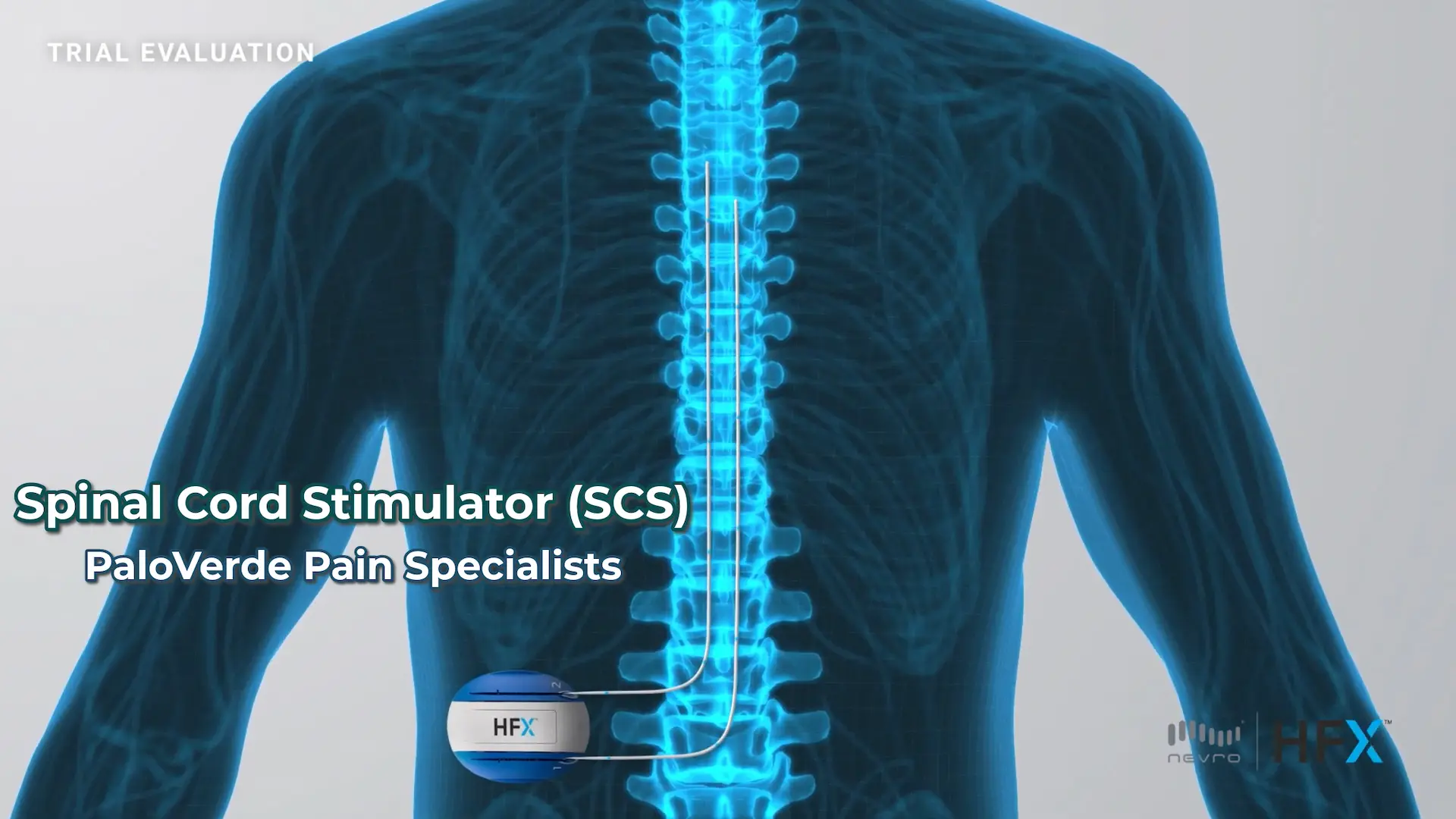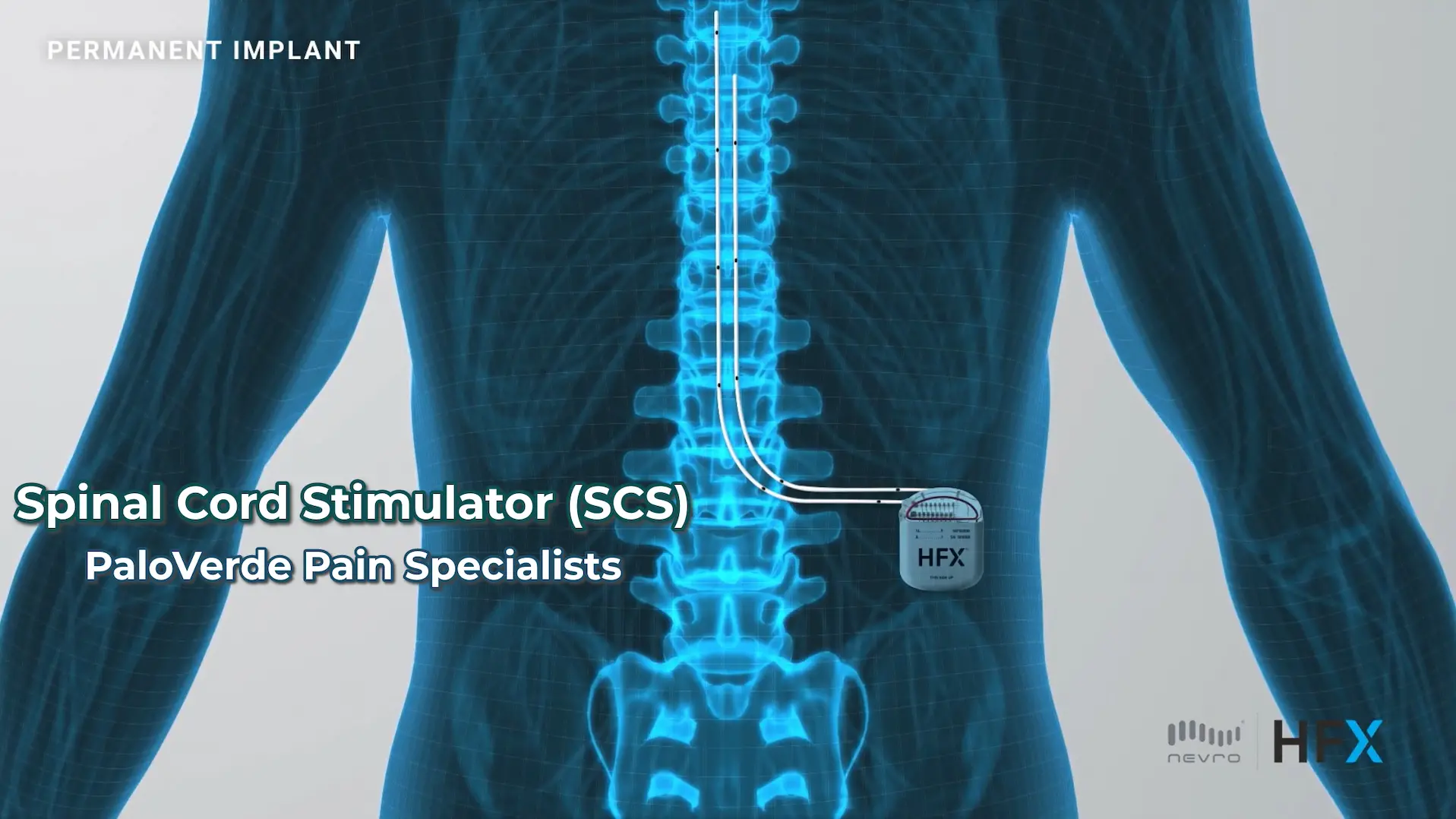Spinal Cord Stimulation
What is a Spinal Cord Stimulator (SCS) Treatment?
A Spinal Cord Stimulator (SCS) is an innovative mechanism used to manage chronic pain by blocking pain signals before they reach your brain. The small device has thin wires, or leads, that are placed into the epidural space in your back. The leads deliver low-voltage electrical impulses from a generator. The pulses interrupt the transmission of pain signals to your brain, which results in a reduction of pain or even a feeling of gentle tingling. The pulses can be regulated, and the system turned off and on, based on your specifications.

How is it beneficial?
The SCS may provide relief from chronic pain in your back, neck, arms or legs, when other treatments have been unsuccessful. It is especially beneficial because you may try out the system with a temporary device for 5 to 7 days. If you feel significant relief during the trial, you may choose to have a permanent system implanted. Many patients experience pain relief years after implantation, and experience a greater quality of life. Here are some of the benefits of spinal cord stimulator treatment:
- Reduced pain: Spinal cord stimulation (SCS) can help to reduce pain levels by sending electrical pulses to the spinal cord. This can block pain signals from reaching the brain.
- Improved quality of life: SCS can help to improve quality of life by reducing pain and allowing people to participate in more activities. It can also help to reduce the need for pain medication, which can have side effects.
- Increased mobility: SCS can help to increase mobility by reducing pain and improving function. This can be especially beneficial for people with chronic pain who have difficulty walking or moving around.
- Reduced medication use: SCS can help to reduce the need for pain medication, which can have side effects such as addiction and liver damage.
- Improved sleep: SCS can help to improve sleep by reducing pain and allowing people to sleep more soundly.
- Improved mood: SCS can help to improve mood by reducing pain and fatigue. This can lead to a more positive outlook on life.
Who is SCS for?
- People with diabetic neuropathy and lumbar stenosis.
- People with chronic pain in the back, neck, or limbs that has not responded to other treatments, such as medication, physical therapy, or injections.
- People with failed back surgery syndrome (FBSS), which is pain that persists or worsens after back surgery.
- People with complex regional pain syndrome (CRPS), a chronic pain condition that affects the limbs.
- People with peripheral neuropathy, a condition that damages the nerves in the hands and feet, causing pain, numbness, and tingling.
- People with angina, a type of chest pain caused by reduced blood flow to the heart.
- People with spinal cord injuries.
What can I expect?
For this short procedure, you receive a local anesthetic (or possibly light sedation), and the procedure site is numbed. The doctor inserts the leads into your back using a needle, and then positions them to the specific location of your pain. After the leads are in place, the doctor connects them to an external generator, which is taped to your back.
Following the procedure, there may be mild discomfort at the procedure site. While the procedure site heals, keep it dry and clean. Be sure to follow discharge instructions, and contact your doctor if drainage or redness occurs.
Here are some of the limitations of Spinal Cord Stimulation:
- It is not a cure for pain.
- It can have some side effects, such as tingling or numbness in the area where the device is implanted.
- It requires surgery to implant the device.
- The device needs to be replaced every 5-7 years.
The necessary steps of Spinal Cord Stimulation Treatment are as follows:
- Evaluation: The first step is to undergo a thorough evaluation by a pain management specialist. This will include a medical history, physical examination, and imaging studies. The doctor will also discuss the risks and benefits of SCS.
- Trial period: If SCS is a good option for you, you will have a trial period. During this time, a temporary SCS device will be implanted in your back. This will allow you to test the device and see how well it relieves your pain. The trial period typically lasts for 1-2 weeks.
- Permanent implantation: If the trial period is successful, you will have the SCS device permanently implanted. This is a more complex procedure than the trial period, but it is usually done as an outpatient procedure.
How soon will I feel relief?
Many patients feel relief shortly after the trial implementation procedure. If the trial SCS relieves your pain, you may choose to have a SCS permanently implanted. This must take place at a hospital or surgery center. This procedure involves implanting the generator in the abdomen or the buttocks, and adjusting the leads to provide the best pain relief and most coverage of the painful area. The permanent implantation procedure typically takes about 1-2 hours. The system can be removed at a later time if necessary. Studies have shown that many patients experience pain relief for years after the original implant.
After the procedure, you will need to stay in the hospital for a few hours for observation. You may also have some pain and discomfort, but this should improve over time. Once you are discharged from the hospital, you will need to learn how to care for your SCS device. This includes changing the batteries and keeping the incision sites clean and dry. You will also need to see your doctor regularly for follow-up appointments.
SCS is a safe and effective treatment for chronic pain. It is not a cure for pain, but it can help to reduce pain and improve your quality of life. If you are considering SCS, talk to your doctor to learn more about the risks and benefits.
Here are some additional things to keep in mind about SCS:
- SCS is not right for everyone. It is important to discuss your individual circumstances with your doctor.
- SCS can have some side effects, such as tingling, itching, or numbness. These side effects are usually mild and go away on their own.
- SCS can be expensive. The cost of the procedure and the device will vary depending on your insurance coverage.
SCS is generally safe, but there are some risks and side effects associated with the procedure. The most common side effects are:
- Infection: This is the most serious risk of SCS. The risk of infection is about 3%.
- Bleeding: This is a rare side effect of SCS.
- Device migration: This is when the electrodes or pulse generator move out of place. This can cause the pain relief to be less effective.
- Device damage: This is a rare side effect of SCS. It can happen if the device is dropped or if the patient is involved in a fall or other traumatic event.
Other side effects of SCS are less common and may include:
- Tingling or numbness in the area where the electrodes are placed
- Muscle spasms
- Drowsiness
- Headache
- Dizziness
- Skin irritation at the implant site
Most of the side effects of SCS are mild and go away on their own. However, some side effects, such as infection, can be serious and require medical attention.
Overview: Spinal Cord Stimulator Implant (Trial Procedure) in Arizona
Spinal cord stimulation (SCS) uses electrical impulses to relieve chronic pain of the back, arms and legs. It is believed that electrical pulses prevent pain signals from being received by the brain. SCS candidates in Arizona include people who suffer from neuropathic pain and for whom conservative treatments have failed.
Here are some additional things to consider when thinking about the SCS treatment in Phoenix Arizona:
- Location. Peoria is a central location in Phoenix metro area
- Knowledge and Experience. A team with years of experience will ensure the successful rate of the treatment.
- Timing. The availability of the treatment is one of the key to recover from pain at a timely matter.
Advance Technology For Spinal Cord Stimulation Treatment
HFX is a small, FDA-approved spinal cord stimulation device that safely works inside your body to significantly reduce your pain and restore your quality of life. Learn more about this treatment option for long-term chronic pain relief:
The Right Spinal Cord Stimulation Treatment in Peoria & Phoenix
PaloVerde Pain Specialists is a the best choice for spinal cord stimulation treatment in Peoria and Phoenix Metro Areas for a number of reasons:
- Experienced and qualified specialists. PaloVerde Pain Specialists has a team of experienced and qualified pain specialists who are experts in spinal cord stimulation. They are skilled in performing the surgery to implant the device and in programming it to provide optimal pain relief.
- Comprehensive care. PaloVerde Pain Specialists offers a comprehensive approach to spinal cord stimulation treatment. They will work with you to develop a treatment plan that is tailored to your individual needs and goals. This may include other pain management treatments, such as physical therapy, medication management, and injections.
- State-of-the-art technology. PaloVerde Pain Specialists uses the latest and most advanced spinal cord stimulation devices. This ensures that you will receive the most effective possible treatment.
- Patient-centered care. PaloVerde Pain Specialists is committed to providing patient-centered care. They will take the time to understand your pain and to develop a treatment plan that meets your needs and goals.
Here are some specific examples of PaloVerde Pain Specialists’ expertise in spinal cord stimulation:
- They are one of the few pain management clinics in the Peoria & Phoenix Arizona that offers a variety of spinal cord stimulation devices, including paddle leads, dorsal root ganglion (DRG) leads, and percutaneous leads. This allows them to choose the best device for each individual patient.
- They also offer a variety of programming options for spinal cord stimulators. This allows them to fine-tune the device to provide the best possible pain relief for each patient.
- PaloVerde Pain Specialists is also a clinical trial site for new spinal cord stimulation devices and therapies. This means that patients at PaloVerde Pain Specialists have access to the latest and most innovative treatments for chronic pain.
PaloVerde Pain Specialists has been chosen by many patients for for spinal cord stimulation treatment because of their experienced and qualified specialists, comprehensive care, state-of-the-art technology, and patient-centered care. Schedule an appointment today and get back on pain-free life again soon.
